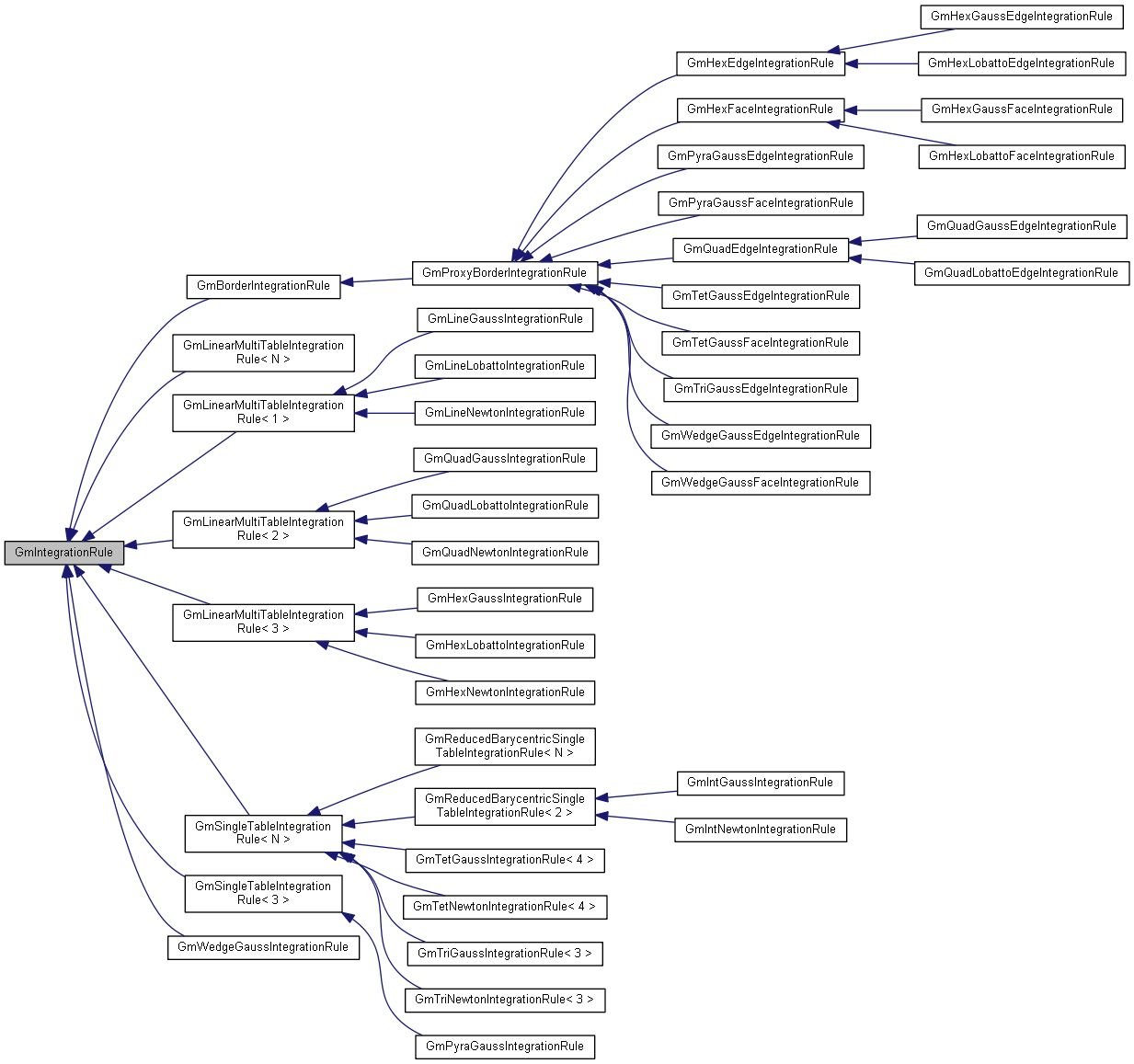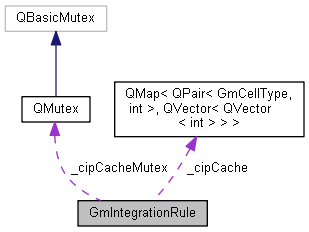 |
GemaCoreLib
The GeMA Core library
|
 |
GemaCoreLib
The GeMA Core library
|
Integration rule base classe. More...
#include <gmIntegrationRule.h>


Public Member Functions | |
| virtual | ~GmIntegrationRule () |
| Virtual destructor. | |
| virtual bool | isValid () const =0 |
| Returns true if this is a valid integration rule object, false if not. More... | |
| virtual int | numPoints () const =0 |
| Returns the number of integration points returned by this rule. | |
| virtual void | integrationPoint (int index, GmVector &naturalCoord, double *weight) const =0 |
| Given an index from 0 to numPoints() - 1, fills naturalCoord and weight with the position and weigth of the given integration point. More... | |
| virtual int | numNaturalCoord () const =0 |
| Returns the number of natural coordinates used by this integration rule. | |
| virtual int | degree () const =0 |
| Returns the integration degree for this rule (The polynomial degree for which this rule is exact) | |
| virtual GmIntegrationRuleType | ruleType () const =0 |
| Returns the type of the integration rule. | |
| virtual QString | ruleName () const =0 |
| Returns the current ruleName adopted by this integration rule. | |
| virtual int | rulePar (int num) const =0 |
| Returns the value of the numbered rule parameter received in the rule constructor (-1 if unused). Num should be a value between 1 and 3. | |
| virtual int | ruleParNumPoints (int num) const =0 |
| virtual int | cacheKey () const =0 |
| Returns an unique integer that can be used to uniquelly represent this kind of integration rule (i.e, two objects with the same cache key should return exactly the same set of integration points). More... | |
| virtual const QVector< int > & | closestIntegrationIndex (GmCellType type, int P, int Q, int nodeIndex) const |
| Returns a list with the index of the closest(s) integraion points from nodeIndex. More... | |
Static Public Member Functions | |
| static GmIntegrationRule * | instance (GmCellType type, int P, int Q, GmIntegrationRuleType irType, int rule1=-1, int rule2=-1, int rule3=-1) |
| Instanciates an integration rule for the specified element type using the provided parameters. Returns NULL if the parameter set results in an invalid integration rule. More... | |
Protected Member Functions | |
| int | makeCacheKey (GmIntegrationRuleCacheKeyBase base, bool closed, int rule1, int rule2=-1, int rule3=-1) const |
| Creates an unique cache key based on the rule type cache key and the rule parameters. | |
| QString | makeRuleName (GmIntegrationRuleType irType, int rule1, int rule2=-1, int rule3=-1) const |
| Returns a standard rule name based on rule type and rule parameters. | |
Static Private Attributes | |
| static QMap< QPair< GmCellType, int >, QVector< QVector< int > > > | _cipCache |
| A global cache, keyed by cell type + cacheKey(), storing the list of closest integration points to a cell node. | |
| static QMutex | _cipCacheMutex |
| The mutex protecting _cipCache. | |
Integration rule base classe.
|
pure virtual |
Returns an unique integer that can be used to uniquelly represent this kind of integration rule (i.e, two objects with the same cache key should return exactly the same set of integration points).
The returned value is used together with an element type as a cache key in closestIntegrationIndex() and in GmShape::gaussExtrapolationMatrix().
Implemented in GmSingleTableIntegrationRule< N >, GmSingleTableIntegrationRule< 3 >, GmLinearMultiTableIntegrationRule< N >, GmLinearMultiTableIntegrationRule< 1 >, GmLinearMultiTableIntegrationRule< 2 >, GmLinearMultiTableIntegrationRule< 3 >, GmProxyBorderIntegrationRule, and GmWedgeGaussIntegrationRule.
|
virtual |
Returns a list with the index of the closest(s) integraion points from nodeIndex.
If more than one integration points are at the same distance to the query index, both will be returned in the list. This function keeps a cache organized by element type / integartion rule storing the list of closests points to a cell node and so, for efficiency, returns a const reference to an internal list.
| type | The element type |
| P,Q | Order parameters for hierarchical elements. Used only for those element types (such as GM_HQUADP or GM_HHEXP). Can be set to 0 for "common" element types. |
| nodeIndex | The (local) index of the query point inside the element. |
All returned points are at the same distance to the node.
|
static |
Instanciates an integration rule for the specified element type using the provided parameters. Returns NULL if the parameter set results in an invalid integration rule.
Parameters P and Q are needed only when working with hierarchical element types, such as GM_HQUADP or GM_HHEXP. They can be set to 0 for "common" element types.
Obs: A call with irType == GM_AUTO_RULE_TYPE and all rules set to -1 will always succeed.
|
pure virtual |
Given an index from 0 to numPoints() - 1, fills naturalCoord and weight with the position and weigth of the given integration point.
After filled, naturalCoord will be a vector with size equal to numNaturalCoord(), which should be equal to the number of natural coordinates of the shape function of the element that this rule will be tied to.
Implemented in GmReducedBarycentricSingleTableIntegrationRule< N >, GmReducedBarycentricSingleTableIntegrationRule< 2 >, GmSingleTableIntegrationRule< N >, GmSingleTableIntegrationRule< 3 >, GmLinearMultiTableIntegrationRule< N >, GmLinearMultiTableIntegrationRule< 1 >, GmLinearMultiTableIntegrationRule< 2 >, GmLinearMultiTableIntegrationRule< 3 >, GmProxyBorderIntegrationRule, and GmWedgeGaussIntegrationRule.
|
pure virtual |
Returns true if this is a valid integration rule object, false if not.
An invalid object can be created when an invalid rule number is passed to the constructor of an integration rule. The result of calling a method other then isValid() over an invalid integration rule is undefined.
Implemented in GmSingleTableIntegrationRule< N >, GmSingleTableIntegrationRule< 3 >, GmLinearMultiTableIntegrationRule< N >, GmLinearMultiTableIntegrationRule< 1 >, GmLinearMultiTableIntegrationRule< 2 >, GmLinearMultiTableIntegrationRule< 3 >, GmProxyBorderIntegrationRule, and GmWedgeGaussIntegrationRule.
|
pure virtual |
Returns the number of integration points associated with the given rule parameter. This is usefull for compound rules to access the number of points in each "dimension". For non compound rules, returns the number of points. Keep in mind that following the rulePar way, it returns -1 for a unknown parameter. In a 2 x 3 quad rule, for example, it should return 2 for parameter 0 and 3 for parameter 1. This method is necessary since for Newton Coates rules for tri/tet elements the number of points is NOT equal to the parameter and when combined in a Wedge this information is necessary.
Implemented in GmSingleTableIntegrationRule< N >, GmSingleTableIntegrationRule< 3 >, GmLinearMultiTableIntegrationRule< N >, GmLinearMultiTableIntegrationRule< 1 >, GmLinearMultiTableIntegrationRule< 2 >, GmLinearMultiTableIntegrationRule< 3 >, GmProxyBorderIntegrationRule, and GmWedgeGaussIntegrationRule.
 1.8.15
1.8.15